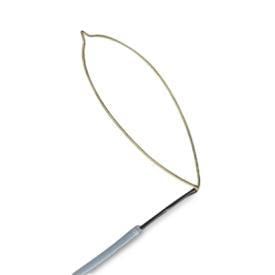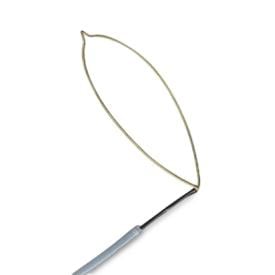How to snare a TAVI when crossing is too complex
A problem-solving step by step tutorial
Crossing the aortic valve can pose significant challenges, particularly in cases involving a horizontal aorta, bulky asymmetric calcifications, or prior prosthesis implantation in valve-in-valve procedures. While some TAVI devices feature deflectable delivery systems to enhance coaxiality, current self-expanding valves lack this capability. When standard techniques like "push and pull," predilatation, or buddy systems fail, advanced methods such as lateral traction with a snare may be necessary to navigate complex anatomies effectively.
Frequency of the problem:
Expert level:
Summary
As transcatheter aortic valve implantation (TAVI) is being offered to an increasing number of patients, hostile anatomies are becoming frequent in daily practice.
Despite multiple maneuvers, calcium distribution and aortic horizontality may hinder valve crossing, enhancing the risk of aortic damage. In such cases, valve snaring can help address this issue.
The problem
Crossing the aortic valve can be challenging in case of horizontal aorta, bulky asymmetric calcifications (especially located on the outer aortic curvature), large sino-tubular junction or with previously implanted prosthesis in cases of valve-in-valve procedures (Video 1).
Among currently available TAVI devices, some devices (Sapien, Octacor) have a deflectable delivery system which help to improve the coaxiality between the delivery system and the aortic valve. Current generation of self-expanding valves cannot change the angulation of the delivery system during its navigation inside the aorta.
Principal idea
If valve crossing is unsuccessful, multiple techniques can be applied (“push and pull”, rotating the delivery system, using a stiffer wire, predilatation, buddy wire, buddy balloon or balloon-assisted tracking)1.
When these fail, the force vector across the valve can be deflected by applying a lateral traction through the use of a snare, as first described by Naganuma et al2.
Material needed
- Single loop gooseneck snare (Figure 1).

Figure 1. Single loop gooseneck snare.
Step-by-step method
Step 1: is a snare needed?
Snaring is mainly used as a bailout option, in order to keep procedural complexity and expenses as low as possible.
Nevertheless, if pre-operative computed tomography shows a high risk of difficult valve crossing, snaring can be planned and positioned at the beginning of the procedure.
Multiple maneuvers around the calcific aortic valve enhance the risk of stroke, therefore if a snare is needed, an embolic protection device may be helpful.
Step 2: snare selection
A large snare (30 mm loop) is preferable. A cath lab with a high TAVI volume should have appropriately sized snares available.
However, smaller snares or homemade snares can be equally effective. How to create a homemade snare has been described in a previous My Toolkit article.
Step 3: access selection
Snaring should always be performed from the contralateral access to increase its effectiveness. Snaring can be performed both from radial and femoral access, and requires a 6Fr introducer sheath to be advanced3. Snaring is maneuvered inside of a JR 6Fr guiding catheter, but also other guiding catheters can be utilized according to different anatomies.
In case of snaring as bailout strategy, access choice depends on the initial setup:
- If the initial setup is femoral as main access plus radial as secondary access, the recommendation is to take the contralateral 6Fr femoral access.
- If the initial setup is bi-femoral, the snare can be advanced from a bailout 6 Fr radial access or from the contralateral femoral access placing a 12Fr sheath to accommodate a diagnostic 5 or 6Fr pigtail and a 6Fr JR with the snare inside.
Step 4: snaring the valve
Snaring can be performed in any tract of the aorta. Snaring in descending aorta is more common in case of planned procedures, while the ascending aorta is easier in case of bailout snaring (Video 2).
If snaring is unsuccessful in one position, the other one should be tried.
When an ipsilateral access is used, the wire or the catheter can be snared outside the body4. However, this solution can be ineffective.
If snaring is used as a bailout strategy, in case of retrievable valves, it is necessary to retrieve the valve from the ventricle together with the wire and to repeat the maneuvers with the snare already in place.
The snare is initially positioned around the wire, then moved upwards until it reaches the bottom end of the delivery capsule, where it is tightened (Video 3).
The exact snaring point may vary slightly among different TAVI devices.
Step 5: traction
Once tightened, snare is pulled along the inner aortic curvature. Meanwhile, the delivery system is pushed up to a successful crossing (Video 4).
Step 6: removing the snare and releasing the valve
After crossing, the snare is flowered out and retracted towards the aorta. After valve release, the delivery system and the snare are sequentially removed (Video 5).
Handmade snares have the advantage that then can be removed without removing the valve from the LV2. This is helpful in case of hemodynamic instability, requiring left ventricular support or coronary interventions after crossing the valve.
Points of specific attention
- Gentle traction is usually sufficient.
- If snaring is planned beforehand, position the snare in the descending aorta before introducing the crossing wire.
- It is recommended to have a personal flowchart of techniques to implement in a stepwise fashion when crossing is complex.
References
- Yearoo I, Joshi N V., Turner M, Mahadevan K, Dorman SH. Novel Techniques to Crossing a Severely Stenotic Aortic Valve. JACC Case Rep. 2019;1:848–852.
- Naganuma T, Kawamoto H, Hirokazu O, Nakamura S. Successful use of the loop snare technique for crossing a degenerated surgical valve with the Evolut‐R system. Catheterization and Cardiovascular Interventions. 2019;93.
- Kunkel KJ, Fiorilli P, Kobayashi T, Desai ND, Anwaruddin S, Herrmann HC. Snare-Assisted Valve Positioning of Self-Expanding Valves for Transcatheter Aortic Valve Replacement. JACC Case Rep. 2021;3:658–662.
- Fukutomi M, Onishi T, Ando T, Tobaru T. Ipsilateral snare technique for the safe delivery of the Evolut PRO transcatheter aortic valve system: a case report. Eur Heart J Case Rep. 2023;7.
A word from the reviewer - Moritz Seiffert
Failure to cross the aortic valve with the delivery system during a TAVI procedure for the treatment of severe aortic stenosis remains a rare but potentially stressful situation.
Several anatomical and procedural aspects may impede the positioning of the valve delivery system within the aortic valve. These include bulky calcifications of the valve, a horizontal and/or dilated aorta or sinuses, and valve-in-valve procedures.
The authors describe a concise step-by-step approach to overcome this procedural difficulty with simple and straight-forward maneuvers.
TAVI operators should familiarize themselves with these tools and the steps required to overcome this potential challenge in a structured approach and to be prepared once they face this situation.
Disclosures
The authors declare no conflicts of interest to disclose.
Marta Bande is an interventional cardiologist and an employee of Boston Scientific Corporation. She has no conflict of interest to disclose regarding this article.
Authors











No comments yet!